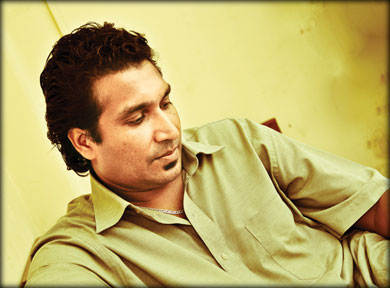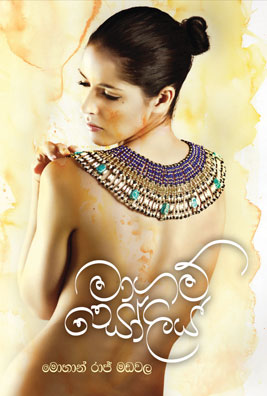Magic realism to the fore
by Charith Perera
Magam Soliya by Mohan Raj Madawala would mark a seminal trajectory in
the evolution of contemporary Sinhala novel. It stands out among
contemporary Sinhala novels for its impressive diction, use of diverse
narrative modes as well as creating a surreal fictional realm within the
matrix of a traditional village in transition against the backdrop of a
turbulent period in the history of the nation.
|

Mohan Raj Madawala |
The extremely grabbing narrative is interspersed with magic and
supernatural occurrences, practice of black magic and occult,
deeply-rooted Asian mystic spirituality and in the periphery of the
evolving saga of the village with its myriad of inter-personal
relationships, chants, rituals, miraculous occurrences and dominant
morality and sexuality, is ranging Uva Wellasa rebellion.
Mohan Raj Madawala’s Magam Solyai, opens diverse avenues of inquiry,
marking a seminal trajectory in the evolution of contemporary Sinhala
novel. One of the significant aspects of the narrative is the
criss-crossing of literary genres. It is, indeed, hard to classify Magam
Soliya into a prominent literary genres such as magic realism,
historical novel or purely fantasy like The Lord of the Rings.
What is obvious, however, is that the novelist has, in his own way,
salvaged the contemporary Sinhala novel from the quicksand of largely
misunderstood ‘postmodernist novel’ and from the filthy discourse in
Sinhala novel which led to the birth of scores of tirash, reflecting
nothing but the wierd mind of the authors. In fact, The present crisis
in the contemporary Sinhala novel seems to be in the form as well as in
the content.
Fictional realm
The novel is woven around a fictional village at the edge of
wilderness against the backdrop of turbulent time with the formation of
the Uva Wellassa rebellion against the British rule in Sri Lanka.
The novel commences with a description of the temple which is the
nucleus of the social activities in the village and offering a brief
history of the temple and of the village.
Through the family of Punchi Rala and the villagers, the author
portrays complex web of interpersonal connections in the village among
the villagers and the pivotal role the Buddhist temple plays in its
affairs.
 The narrative is interspersed with magic and supernatural
occurrences. However, the author has been able to narrate the events in
such a way that they seem as real or very close to reality. The narrative is interspersed with magic and supernatural
occurrences. However, the author has been able to narrate the events in
such a way that they seem as real or very close to reality.
It is this aspect of the narrative which reminds the reader of
Gabriel Garcia Marquez’s One Hundred Years of Solitude.
In an academic paper titled ‘Magic Realism in Gabriel Garcia
Marquez’s One Hundred Years of Solitude, B.J Geetha says prominent
characteristic of magic realism is that the author’s ability to present
magic and supernatural occurrence as if the events are commonplace.
“Magic realism is a literary form in which odd, eerie, and dreamlike
tales are related as if the events were commonplace. Magic realism is
the opposite of the “once-upon-a-time” style of story-telling in which
the author emphasizes the fantastic quality of imaginary events.
Magic realism
In the world of magic realism, the narrator speaks of the surreal so
naturally it becomes real. Magic realism in its literary and artistic
applications aimed to re-imagine the world and its reality. It is not an
escapist venture but rather an opportunity to see the fantastic in the
everyday. There are multiple stylistic traits of magic realism.
The key, however, is rejection of subjectivity and emotionalism,
simultaneity of past, present and future and defamiliarisation.
However, these traits distinguish magic realism from the fantasy
genre. In fantasy novels, the created world must have an internal logic.
Magic realism, however, is not subject to natural or physical laws.”
Mohan Raja Madawala has made use of traditional occultism, black magic
and Asian mystic spirituality as sources of the magic and supernatural
occurrences. What is queer is that Valli , a young woman , acquires her
magic powers through her mother’s spirit Gomari who is alive. Characters
such as Podina , a village midwife and wet-nurse who takes care of
Puncha, who is unconscious boy by birth and his only nourishment is
Podina’s breast milk. Most of the characters of the novel are
extraordinary in different manners.
Apart from Valli’s black magic, events such as pregnancy of Manika
who was a maiden and had never had sex with a man and she only had
eye-contact with Bindu, the author tries to portray a pre-colonial
largely self-sufficient village.
The author narrates the event in a convincing manner; “She understood
the events well. Before Bindu died, She recalled how both of them (Bindu
and Mankia) were looking at each other’s naked bodies almost like in a
meditative mood for more than a week , without ever touching each
other’s bodies and they were secluded from others.” It is a queer case
of conception by sight.
The difference between Mohan Raj and Garcia Marquez is that
apparently, Mohan has not used elements of fantasy and magic to address
some specific themes. It is obvious that magic and fantasy elements have
been used to portray the kind of belief systems and the occultism
prevalent at the time.
Themes
In contrast Marquez uses magic realism to address specific issues and
deal with diverse themes. B.J Geetha said, “Gabriel uses the form of
magical realism and the content derived from history and politics to
address some of the most difficult and meaningful themes.
He addresses war, suffering, and death with clarity and political
slant. By the mid-1960’s, Colombia had witnessed in excess of
two-hundred-thousand politically motivated deaths.” One of the
significant traits of Magam Soliya is that it bears typical
characteristics, to a certain extent, of a historical novel. But, it
also differs to characteristic Sinhalese historical novels such as W.A
Silva’s Sunethra which is woven around a single episode in the history.
Although Magam Soliya is set in the pre-colonial Sri Lanka against the
brewing of the Uva Wellasa rebellion, historical events are peripheral
to the plot. It is towards the end of the narrative that repercussions
of the rebelling would make a profound impact on the lives of the
villagers.
Given the dubious nature of generic definition of historical novel,
it is hard to put Magam Soliya into the category of historical novel.
Carlos Mata Indurain in an academic paper titled ‘Brief Definition
and Characterisation of a Historical Novel said, “What makes it possible
for us to bring together under this heading such dissimilar works as
Ivanhoe and The Charterhouse of Parma, War and Peace and The Last of the
Mohicans, The Lord of Bembibre and Bomarzo? We all have, with a greater
or lesser degree of precision, a notion of what a historical novel is,
and intuitively possess the certainty of whether a novel is historical
or not. But when we consider a generic definition, the question is not
so simple. The most obvious characteristic is that in all the above
mentioned novels, so different from one another, the (fictitious,
invented) action takes place in a more or less distant (real,
historical) past. This is a first approximation that, even though it is
still too vague and general, coincides with a definition provided by
Buendía: ‘To define the historical novel strictly speaking means simply
saying that a novelistic action unfolds in the past; its main characters
are imaginary, whereas the historical figures and the real facts
constitute the secondary element of the story.”
Civilisation
Significantly, Magam Soliya is not a just recalling of a history of a
village at the periphery of civilisation but a narrative which codifies
an important phase in the evolution of the village with its agricultural
based economy. Punchi Rala, one of the main characters of the novel, was
a hard-working farmer who cultivated grains and vegetables in a farm in
the forest.
Through the cohabitation between Vali and Punchi Rala , the author
portrays a kind of sex life in the village. Being Vali’s father, the
cohabitation is incestual and the author hints out that it may be part
and parcel of the moral code of the village. However, the graphic
descriptions of love making in the novel, does not, certainly, warrant
it to be bluntly classified as sex thriller or a thrash as such scenes
were organically incorporated into the plot.
Through the spiritual life of the chief bhikkhu of the village temple
and then, Upasaka Unnase, a layman who assumes the role of the bhikkhu
and also cohabitates with a woman, the author depicts the spiritual
development and through the character of Vali, the author discusses the
occultism and black magic. One such incident is when Vali made a charm
on Podi Nilame with whom Vali had a passionate relationship when he
married a woman from a neigbouring village. According to the charm, the
newly wedded couple could not have sex as they begin to see each other
as incarnated devils.
“By that time, they were panting having had a fierce fight with
considerable bloodletting. Their honeymoon bed had turned into a virtual
battlefield with torn out garments and bedsheets. As Podi Nilame could
no longer bear the foul smell and heat, he threw off the piece of cloth
wrapped around his waist and wore a fresh one and had gone into the
courtyard. It was well past the mightnight. How could I see her as a
she-devil? And she could see him as a devil. Am I really a devil? He was
thoroughly confused.”
The novel is full of such events and it is obvious that the author
has exploited traditional belief systems, black magic and occultism to
lend the narrative a mystic texture. The author has effectively used
colloquial idiom and an impressive diction that it makes Magam Soliya a
compelling read. What is noteworthy in the narrative is that Mohan Raj
has demonstrated in no uncertain terms, that the contemporary Sinhalese
authors could always experiment with diverse narrative modes,
criss-crossing diverse literary genres. |


